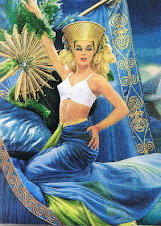
I have always favored vintage plastic jewerly and have been intriged with bakelite and others but celluloid is truly capitaving. Many times it is carved as showen in the above photo. This is one way of idnetifing this chariming plastic.
Webster's Revised Unabridged Dictionary (1913) Tells us that Celluloid (n.) is
a " substance composed essentially of gun cotton and camphor, and when pure resembling ivory in texture and color, but variously colored to imitate coral, tortoise shell, amber, malachite, etc. It is used in the manufacture of jewelry and many small articles, as combs, brushes, collars, and cuffs; -- originally called xylonite."
I learned that celluloid was one of the first plastics used for jewelry. This is a PLANT FIBER ! A natural product that was developed in the 1850s in England.
Later, John Wesley Hyatt commercialized the use of celluloid. The use of this material in vintage jewelry is quite old dating to about 1900.
Popular as a material during the Art Deco period which is from 1920-1935, it was made into all kinds of useful things , such as hair combs and clips.
Highly carved designs were often found on celluloid jewelry pieces, ( as the above photo shows) and flowers and leaves were commonly seen.
"One of the biggest uses of celluloid in vintage jewelry was to make brooches and dress clips, especially during the early 20th century. Celluloid looks similar to some other vintage plastics, but it differs in many ways. It is generally much thinner and lighter than bakelite. It is also much more brittle and can crack when exposed to high heat temperatures - sometimes even being flammable. Even though it can be brittle, it can still be twisted or bent into shape quite easily.
To test a piece of jewelry to see if it is celluloid, hold the item under hot water. it will smell like camphor or vinegar. Never use a hot pin test on celluloid because of the flammability factor." (Today's Vintage Jewelry Word - Celluloid )






















